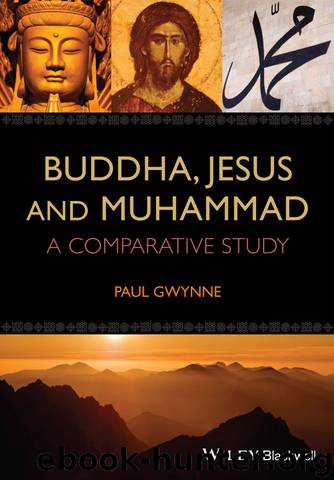Buddha, Jesus and Muhammad: A Comparative Study by Paul Gwynne

Author:Paul Gwynne [Gwynne, Paul]
Language: eng
Format: azw3, epub
Publisher: Wiley
Published: 2013-12-22T16:00:00+00:00
Once again, the hadith fleshes out the enigmatic Qur'anic material. No dates are given, but the general consensus is that the Night Journey occurred in either 620 or 621, just prior to the Hijra. One evening, Muhammad was visiting the Ka'ba when the angel of revelation, Gabriel, appeared to him and announced that they were about to embark on a journey. Suddenly, there appeared a white, winged animal that resembled a mule.76 Named Buraq by the tradition, its stride reached to the horizon and so Muhammad mounted it and was rapidly carried away into the night.77
The two terms – Isra' and Mir‘aj – indicate the two stages of the journey. Isra’ denotes the first stage, which ended at “the furthest mosque” (al-Masjid al-Aqsa). Although no specific earthly location is named, tradition has identified it as the Temple Mount in Jerusalem, now known in Islam as the Holy Sanctuary (Haram al-Sharif).78 Mir‘aj (literally “ascent”) refers to the second stage, from Jerusalem to the various levels of heaven. According to Bukhari, Muhammad met key biblical figures in each of the seven celestial echelons: Adam in the first; John the Baptist and Jesus in the second; Joseph in the third; Enoch (Idris) in the fourth; Aaron in the fifth; Moses in the sixth; and Abraham in the seventh.79 At this point, Muhammad reached the absolute limit for any creature seeking to approach the Creator – a boundary symbolized by the heavenly Lote Tree.80
In the classical period of Islamic theology, scholars debated whether the Night Journey was physical or spiritual. On one hand, authors such as al-Tabari and Ibn Kathir presume that Muhammad's body actually travelled to Jerusalem and then to the heavens. On the other hand, Ibn Ishaq and others interpret the experience as occurring in Muhammad's spiritual consciousness. They are supported by ‘A’isha, Muhammad's third wife, who stated that “the apostle's body remained where it was but God removed his spirit by night”.81 Irrespective of the actual manner of the journey, the key point here is that it was not a public miracle such as the Buddha's magnificent descent from Tavatimsa Heaven or the Transfiguration of Jesus, which occurred in the presence of Peter, James and John.82 In contrast, there were no witnesses to the Night Journey. It was essentially a private mystical experience, albeit one that had tremendous impact on Muhammad and constitutes a second turning point in his career. Disheartened by years of rejection in Mecca and saddened by the recent deaths of Khadija and Abu Talib, the Night Journey could not have come at a better time for Muhammad. However, the private nature of the Night Journey meant that it could not function as an unambiguous confirmation of Muhammad's claim to prophetic authority. Most people simply did not believe Muhammad when he recounted his adventure, although Abu Bakr did and is consequently admired as the epitome of trusting faith. Al-Tabari adds that Muhammad was able to describe in considerable detail a caravan that was headed to Mecca at the time.
Download
Buddha, Jesus and Muhammad: A Comparative Study by Paul Gwynne.epub
This site does not store any files on its server. We only index and link to content provided by other sites. Please contact the content providers to delete copyright contents if any and email us, we'll remove relevant links or contents immediately.
The Lost Art of Listening by Michael P. Nichols(7409)
Why I Am Not A Calvinist by Dr. Peter S. Ruckman(4103)
The Rosicrucians by Christopher McIntosh(3467)
Wicca: a guide for the solitary practitioner by Scott Cunningham(3127)
Signature in the Cell: DNA and the Evidence for Intelligent Design by Stephen C. Meyer(3071)
Real Sex by Lauren F. Winner(2968)
The Holy Spirit by Billy Graham(2893)
To Light a Sacred Flame by Silver RavenWolf(2768)
The End of Faith by Sam Harris(2691)
The Gnostic Gospels by Pagels Elaine(2472)
Waking Up by Sam Harris(2392)
Nine Parts of Desire by Geraldine Brooks(2326)
Jesus by Paul Johnson(2310)
Devil, The by Almond Philip C(2282)
The God delusion by Richard Dawkins(2265)
Heavens on Earth by Michael Shermer(2237)
Kundalini by Gopi Krishna(2137)
Chosen by God by R. C. Sproul(2123)
The Nature of Consciousness by Rupert Spira(2047)
